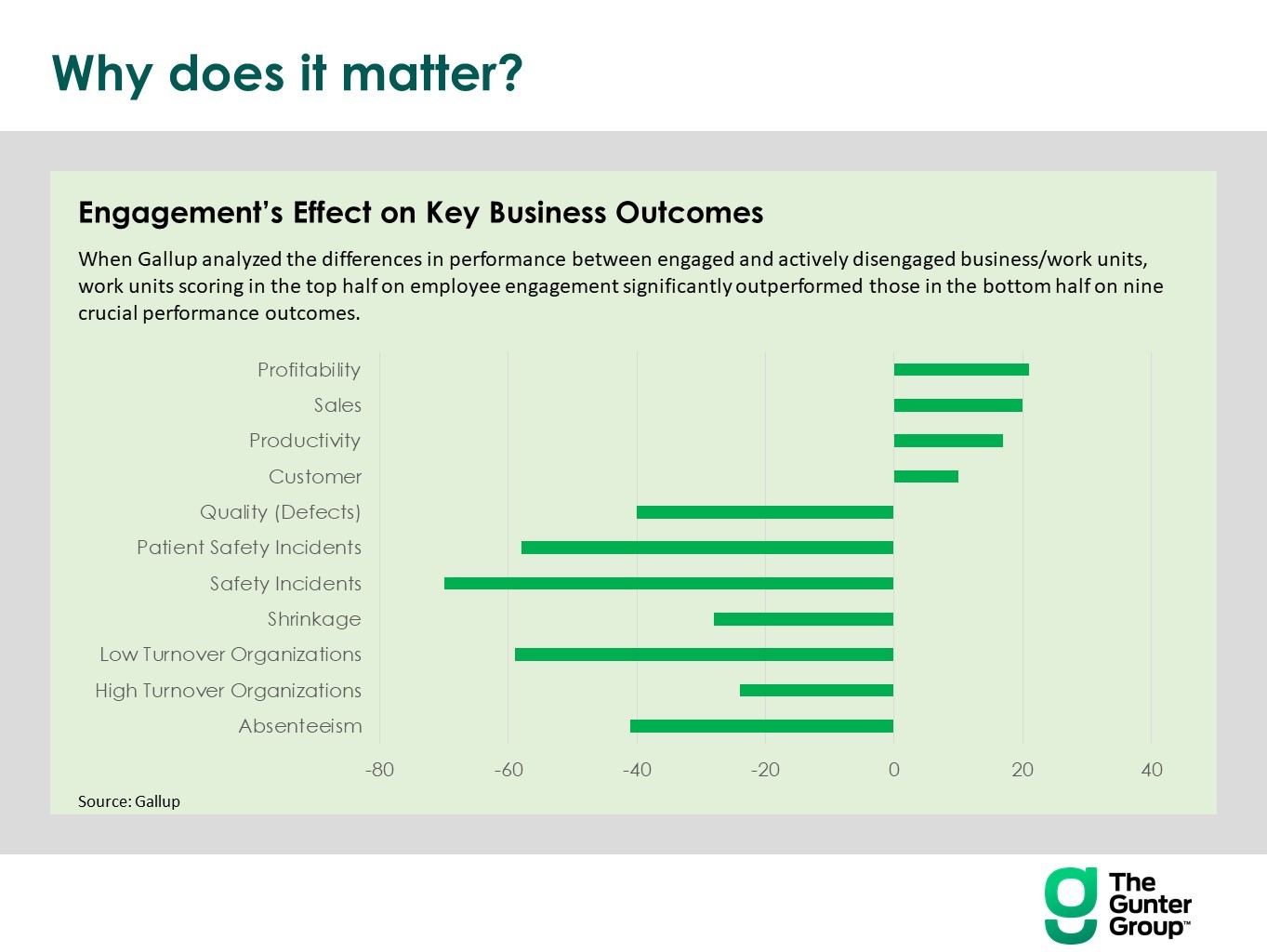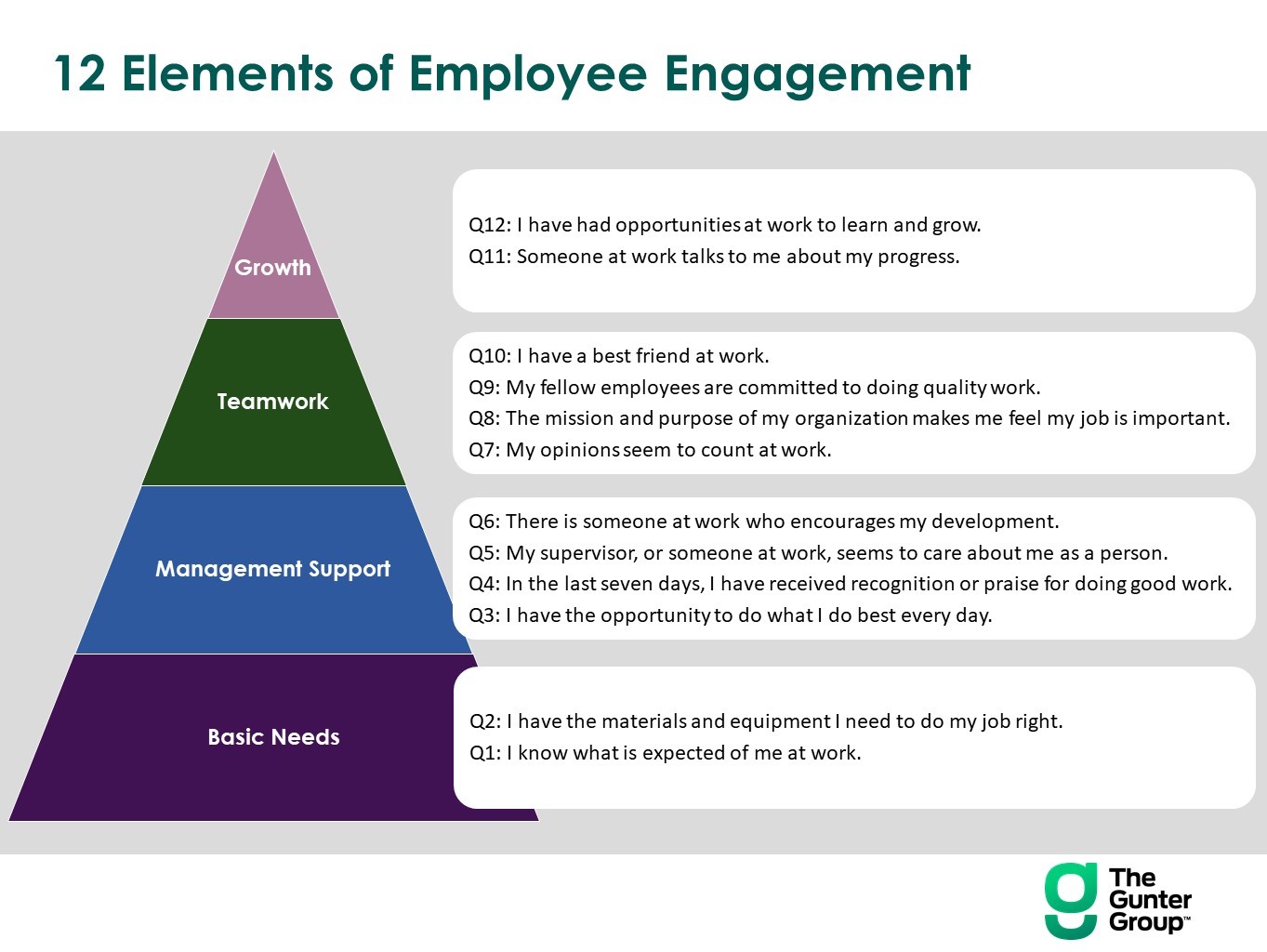Blog
EMPLOYEE ENGAGEMENT
By Ashleigh Gunter, Managing Partner, and Laura Magrone, Consultant at The Gunter Group.
If you could improve your company’s profits by 21%, reduce attrition by 24% to 59%, and improve your employees’ morale—all without significant cash outflow or investment—would you do it (1)? It is doubtful anyone would answer no to the above question, although that is what many are essentially doing when they don’t make employee engagement a priority in their organization.
Employee engagement extends far beyond simply measuring employee satisfaction; it can be defined as a measure of employee commitment to the organization, which drives company performance and outcomes. It is the act of including all employees in a conversation about what would make your organization better and then including each and every one of them in an action plan to drive changes. This is a proven effective approach for organizations of all sizes.
Business outcomes are directly impacted by employee engagement and are a key driver for implementing an employee engagement program. In an analysis completed by Gallup, a popular vendor for employee engagement surveys, results revealed that groups with higher employee engagement ratings significantly outperformed groups with lower ratings on crucial performance outcomes, including decreased turnover rates (2).

Establishing an Employee Engagement Program
Once you’ve decided to embark on improving employee engagement, you need to first consider how you will measure engagement. There are a wide variety of tools and vendors you can use, ranging from self-administered surveys to integrated platforms with extensive consulting support. If you choose to create your own and use something straightforward like SurveyMonkey, keep your survey simple. We recommend using publically available engagement questions rather than trying to develop new questions on your own. This will save you the time and effort of figuring out how to ask the right questions.
The Gallup organization has spent years developing the science around employee engagement. After millions of surveys, interviews, and significant in-depth analysis, they devised 12 statements as the key drivers of employee engagement. In the book 12: The Elements of Great Managing, Rodd Wagner and James K. Harter, Ph.D. describe these elements in detail. Here they are at a glance:

The 12 elements can be categorized based on four key areas: Basic Needs, Management Support, Teamwork, and Growth. These must be viewed as foundational. Basic Needs must be met before shifting to Management Support. Management Support must be solid before focusing on Teamwork, and so on. When using an engagement survey provided by Gallup, the results include these 12 elements and are helpful in honing focus areas to ensure your employees’ needs are being met.
If you choose to engage with a vendor that provides an engagement survey tool or provides a package of tools and consulting services, make your selections based on the availability of benchmark comparisons, confidentiality, cost-effectiveness, ability to view segmented results (department, tenure, function), and flexibility of question format. Take time to carefully consider these criteria and select something that will work for your organization in the long-term.
After selecting a tool/vendor, you should determine an effective communication strategy to launch the program, ensuring employees know why, how, what, and when the program is happening. Participation is critical. If you only get a small percentage of your organization to respond to the survey, you won’t have meaningful data. Too often, only the employees who are really unhappy or are really happy end up responding, leaving the employer with an inaccurate view of true engagement across the company. It is okay to provide incentives to encourage employees to participate in the survey. It is not okay for managers to tell employees that they have to take the survey. We’ll review more common pitfalls when implementing an employee engagement program below.
Once the results are received back from your employees, it’s time to get to work! Most employers make the mistake of assuming that they should take the results of the survey and ‘fix things’ for their employees. However, what we find is that this leader-led approach doesn’t improve engagement. What actually improves engagement is including all employees in the process of reviewing the results and making a commitment to change one item in each work group and then following through on that commitment. For instance, one of the clients I work with had a team who worked through how to improve vacation coverage for one another. The approach provided a softer re-entry to work and enabled employees to enjoy their vacations more and not stress too much about coming back. This led to increased engagement within the team and was a win for all involved.
While this approach sounds easy, it still requires very clear communication to employees and good engagement meeting facilitation. When employees review engagement results, they often want to focus on what they cannot control. For instance, “If I just got paid more, I would be so much more engaged” or “If I had five more days of vacation each year, things would be so much better.” The leader in the conversation must focus the discussion on what your team can change rather than what the team wishes the leadership would change. Once they can land on a specific thing to change, then the team needs to collectively commit to an improvement plan and determine how best to track and report progress against it. Don’t forget to share your results with others so that successful ideas can be replicated across the organization when appropriate. Sharing results also builds momentum and motivation to continue building on your employee engagement program.
There are some common pitfalls many organizations encounter which can undermine an entire employee engagement program. They are (3):
Lack of trust in confidentiality. Employees will not answer questions honestly if they aren’t confident that their answers will be confidential. Once confidentiality is compromised, it’s very difficult to rebuild trust in a survey. This often occurs when management attempts to determine by process of elimination how employees responded.
Lack of transparency. If scores come back low, an honest conversation is necessary—don’t just gloss over the low scores for fear of adversely affecting morale or to avoid difficult conversations. Focusing on problem areas and developing an action plan to address them will yield the greatest results.
Preferring high scores to honest feedback. Treat low scores as an opportunity for improvement and encourage employees to provide honest feedback without fear of repercussion.
Measuring managers by their scores. This can have a two-fold effect. Managers may pressure their employees to respond favorably in an employee engagement survey leading to skewed results. Alternatively, employees may not answer questions honestly for fear of negatively impacting their manager’s success.
Poor change management. If you don’t explain the survey and provide enough support to ensure managers are able to have honest conversations with their teams about the survey results, the activity becomes more of a ‘check the box’ than an opportunity for understanding and greater engagement. Be sure to take the time to prepare the entire organization for the process—in particular, the management team, who will need to facilitate the conversations with their teams.
Delayed communication. Survey results should be reviewed and an action plan should be developed as soon as possible. If there is substantial lag time between the survey and results, the engagement program becomes distant and possibly even forgotten.
Executive involvement. The most successful employee engagement programs are championed by senior leaders who promote accountability and follow-through. However, executives CANNOT decide that they will respond to the survey to fix everything, ultimately taking control from the employee population for improving the engagement.
In an engaged environment, employees are not only excited to come to work, but are committed to driving toward business goals. They take pride not only in being part of a great team, but in contributing to the success of the business. They are empowered to use their strengths to shine and are energized by doing so. It requires committed leadership and an openness and humility to evaluate yourself and your organization’s growth opportunities. Making employee engagement a priority provides amazing possibilities for improvements both for your employees and your organization as a whole.
References:
1 – https://www.gallup.com/workplace/236366/right-culture-not-employee-satisfaction.aspx
2 – http://news.gallup.com/businessjournal/163130/employee-engagement-drives-growth.aspx
3 – https://www.qualtrics.com/uk/experience-management/employee/engagement/pitfalls-to-avoid/
